
Maybe you’re with me on this: a life lived without carbonated beverages is no life at all. Whether you specifically agree or not, it seems clear humanity as a whole regards adding bubbles to your drinks often a marked improvement. Who wants to drink a flat soda (I’m sure you’re out there, but I refuse to acknowledge you)? Almost everyone prefers a bubbly beer and wine? Well you can have plain old wine any time, but add some bubbles in there? Now it’s a celebration. The same applies to our old friend water; still water is nice, but I like to live life to the fullest, and so my water must be full as well. Full of excitement, full of fun, full of tiny bubbles of CO2. That's right friends, in this post we’re learning how to make our own seltzer!
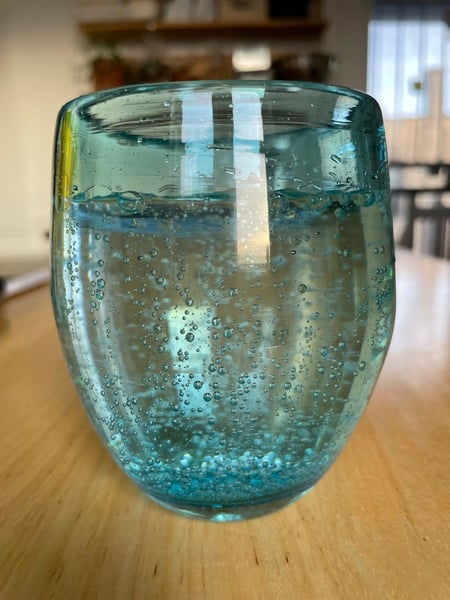 Carbonation is a complex topic and parameters and techniques vary widely depending on what exactly it is that you’re carbonating, so I figured we would start at the beginning with regular water. This way we only have to worry about two things: temperature and pressure. We can forget about dealing with foam or dilution or flavor or anything else that can make home carbonation a discouraging quagmire.
Carbonation is a complex topic and parameters and techniques vary widely depending on what exactly it is that you’re carbonating, so I figured we would start at the beginning with regular water. This way we only have to worry about two things: temperature and pressure. We can forget about dealing with foam or dilution or flavor or anything else that can make home carbonation a discouraging quagmire.
Now of course, there are a few home carbonation units available for purchase, but simple as they are to operate, they are not super cost effective. They use proprietary tanks, and the cost of refilling your gas adds up quick. Maybe you drink so much seltzer the price of brand name CO2 leaves you aghast, maybe you have political reasons for not supporting an at-home seltzer machine company, or maybe you just love to build DIY projects. In any case, making your own at-home carbonation rig is simple, easy to operate, and gives you flexibility those other bubble injectors could only dream of. So, let’s get to it.
I’ll spare you most of the technical stuff, and just say that when it comes to carbonating water there are just a couple things you need to pay attention to: temperature of the water, the headspace in your carbonation vessel, and the pressure at which you are carbonating. For temperature, counterintuitive though it may seem, the colder your liquid is, the more CO2 can be dissolved in it. For making seltzer we want our water as cold as possible. Furthermore we want to leave some headspace (about 1/4 - 1/3 of your bottle) in order to get that gas in there as quickly and easily as possible. And for pressure, I like to carbonate around 45 PSI.
In order to achieve this, however, we will need some equipment.
- A plastic bottle (I use an empty 1.5 liter seltzer bottle, but any plastic bottle that used to hold carbonated liquids will work (Tip: don’t try and use a plastic bottle that held an un-carbonated beverage, they can’t handle the pressure!)
- A 5lb CO2 tank (available online)
- A 120 PSI pressure regulator (available online)
- Some gas hose (available online)
- A ball-lock connector (available online)
- A carbonator cap threaded to fit standard plastic bottles (available online)
Connect the regulator to the tank, the hose to the regulator, and the ball-lock connector to the hose, and you’re in business. Grab your empty bottle.
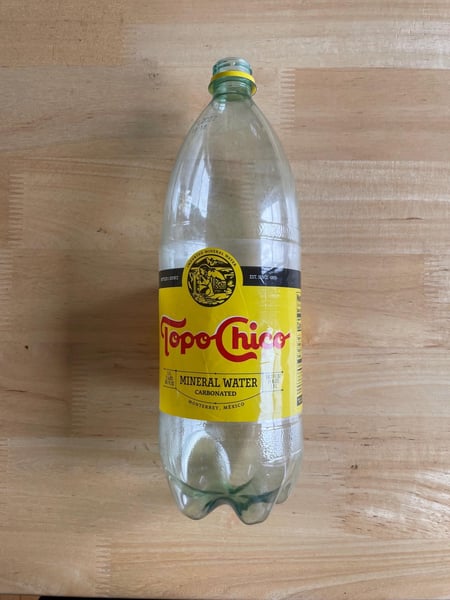 My empty 1.5 L seltzer bottle
My empty 1.5 L seltzer bottle
Fill it with the most delicious water you’ve got.
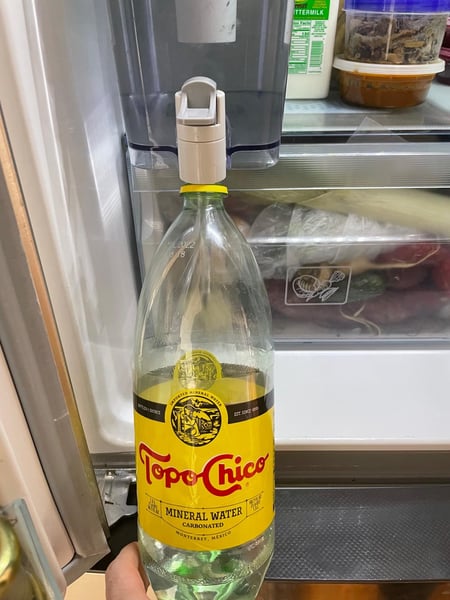 Leave about 1/4 - 1/3 of the bottle empty.
Leave about 1/4 - 1/3 of the bottle empty.
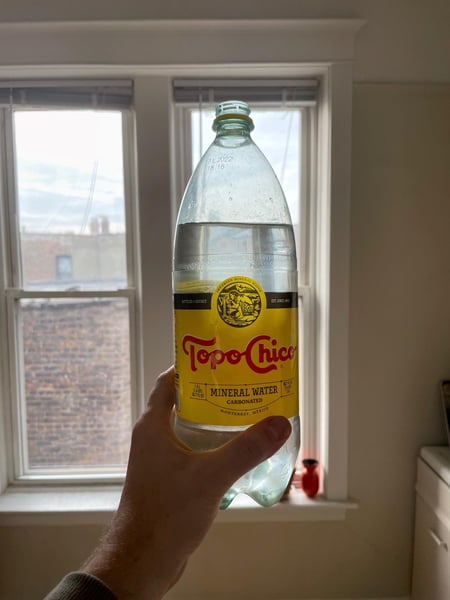 This water, even straight out of my fridge is too warm to carbonate, so…
This water, even straight out of my fridge is too warm to carbonate, so…
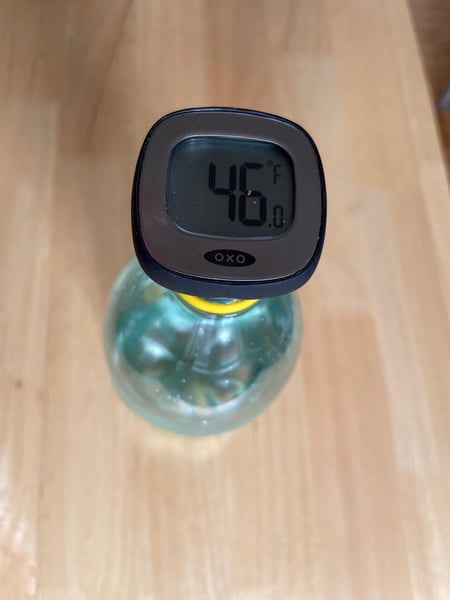 … stick it in the freezer.
… stick it in the freezer.
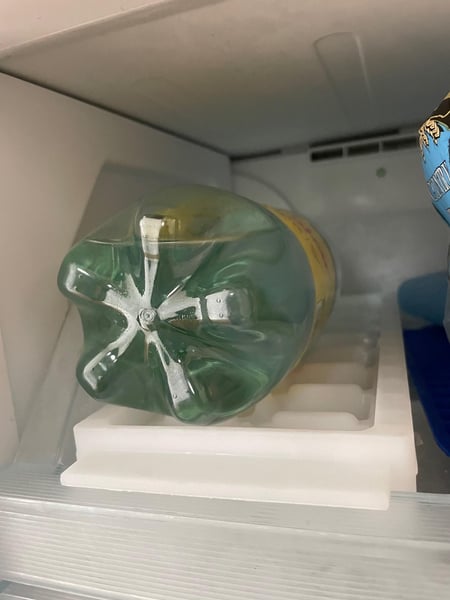 I usually leave it in until I can just start to see ice forming along the sides of the bottle.
I usually leave it in until I can just start to see ice forming along the sides of the bottle.
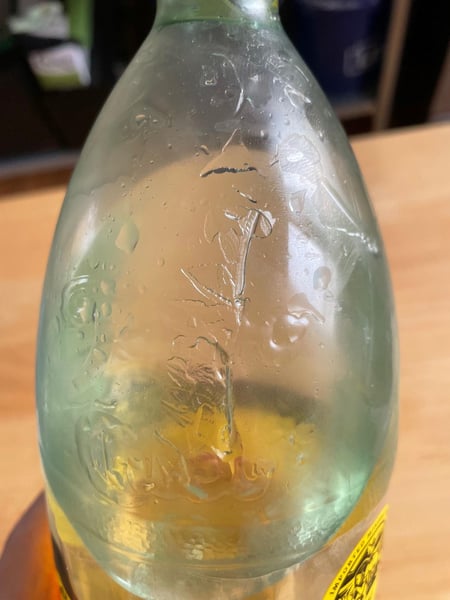 Colder would be better, but this is good enough.
Colder would be better, but this is good enough.
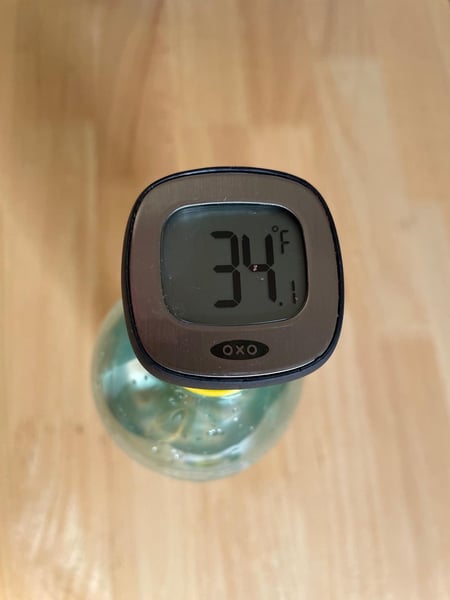 At this point we want to squeeze out as much air as we possibly can, because we want to fill that headspace with CO2.
At this point we want to squeeze out as much air as we possibly can, because we want to fill that headspace with CO2.
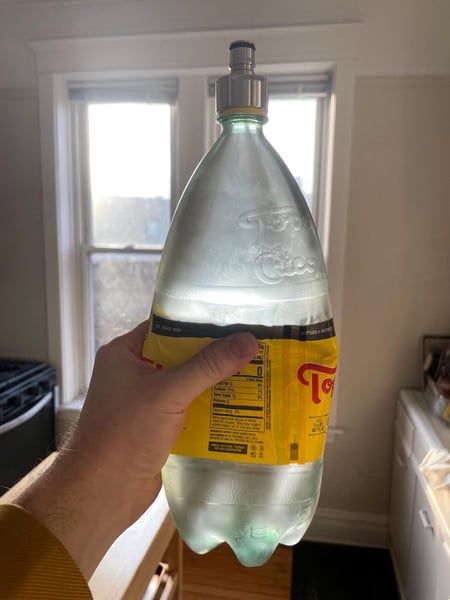 Once you’ve got the air out, screw on your carbonator cap.
Once you’ve got the air out, screw on your carbonator cap.
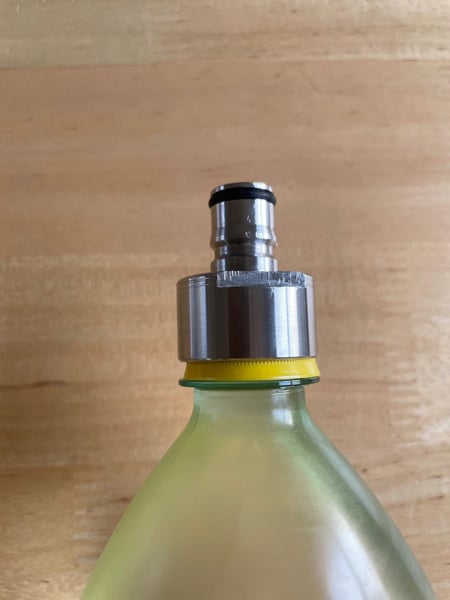
My carbonator cap
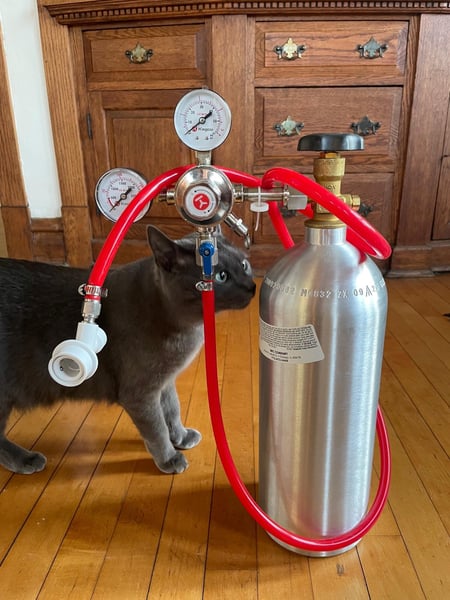 My home carbonation rig, made form the components listed above
My home carbonation rig, made form the components listed above
Open the valve on the CO2 cylinder, and set the regulator to around 45 PSI.
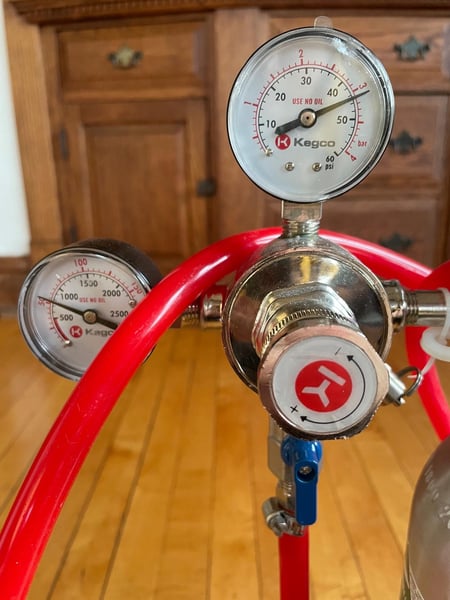 Around 45 PSI
Around 45 PSI
And now for the exciting part. Attach the ball-lock connector to the top of your carbonator cap (it should audibly click into place) and be amazed as the bottle inflates in a fraction of a second!
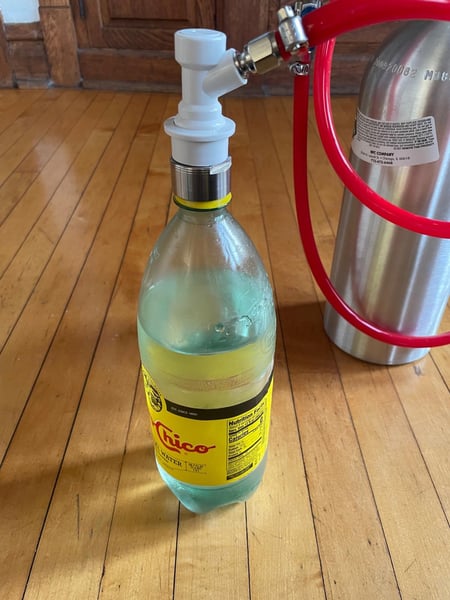 Now, disconnect the ball-lock connector and shake vigorously for about 15-30 seconds. You should feel the CO2 dissolving into solution because the bottle will slowly deflate as you shake it. Pretty cool.
Now, disconnect the ball-lock connector and shake vigorously for about 15-30 seconds. You should feel the CO2 dissolving into solution because the bottle will slowly deflate as you shake it. Pretty cool.
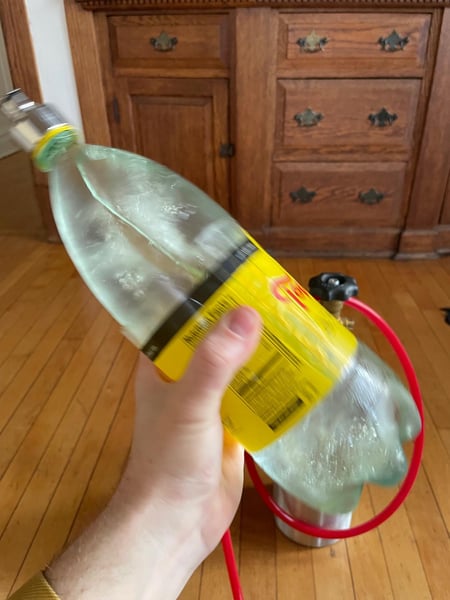 Loosen the carbonator cap just enough to let the excess gas escape, then re-tighten it onto the bottle without ever taking the cap all the way off. Repeat this process until you can see gaps rapidly coming out of solution and forming big bubbles when you do the pressure release step. It took me about 6 repetitions on a bottle this size with this amount of headspace.
Loosen the carbonator cap just enough to let the excess gas escape, then re-tighten it onto the bottle without ever taking the cap all the way off. Repeat this process until you can see gaps rapidly coming out of solution and forming big bubbles when you do the pressure release step. It took me about 6 repetitions on a bottle this size with this amount of headspace.
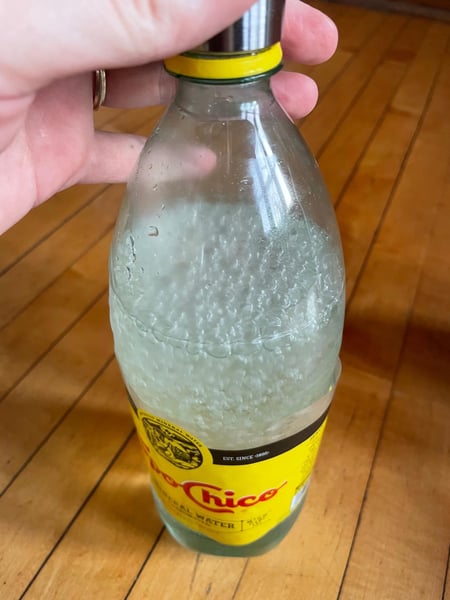 Big bubbles
Big bubbles
Let it rest in the fridge for a minute then pour yourself an ice cold glass of sparkling self-satisfaction.
 Among the many benefits I’ve already listed, there’s actually another nice thing about carbonating your own seltzer in this manner. If you store your bottle in the fridge with the carbonator cap, you never have to worry about it going flat; every time you pour, simply displace the headspace in the bottle with a bit more CO2 and your seltzer will stay in top condition for-basically-ever. You can even use this method to re-carbonate other beverages that have gone flat (even sparkling wine, but don’t tell anybody I told you that).
Among the many benefits I’ve already listed, there’s actually another nice thing about carbonating your own seltzer in this manner. If you store your bottle in the fridge with the carbonator cap, you never have to worry about it going flat; every time you pour, simply displace the headspace in the bottle with a bit more CO2 and your seltzer will stay in top condition for-basically-ever. You can even use this method to re-carbonate other beverages that have gone flat (even sparkling wine, but don’t tell anybody I told you that).
If you’re interested in carbonation and want to take this further, this setup and system is laid out in excruciating detail along with much much more information in the book Liquid Intelligence by Dave Arnold (the smartest man in food and drink), so check out his modern classic if you haven’t already.
And if you want to learn more about delicious sparkling beverages be sure to check out our cocktail class on New Year's Eve: Celebration of Champagne and Bubbles on Friday, December 31 at 5pm at Lincoln Square.

